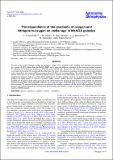Por favor, use este identificador para citar o enlazar a este item:
http://hdl.handle.net/10261/260426COMPARTIR / EXPORTAR:
 SHARE SHARE
 CORE
BASE CORE
BASE
|
|
| Visualizar otros formatos: MARC | Dublin Core | RDF | ORE | MODS | METS | DIDL | DATACITE | |

| Título: | The dependence of the gradients of oxygen and nitrogen-to-oxygen on stellar age in MaNGA galaxies |
Autor: | Zinchenko, I. A.; Vílchez Medina, José Manuel CSIC ORCID; Pérez Montero, Enrique ; Sukhorukov, A. V.; Sobolenko, M.; Duarte Puertas, Salvador | Palabras clave: | Galaxies: abundances Galaxies: evolution H II regions |
Fecha de publicación: | 19-nov-2021 | Editor: | EDP Sciences | Citación: | Astronomy & Astrophysics 655: A58 (2021) | Resumen: | We derived the oxygen abundance (O/H), the nitrogen-To-oxygen (N/O) abundance ratio, and their corresponding radial gradients for a sample of 1431 galaxies from the MaNGA DR15 survey using two different realisations of the strong line method: empirical R calibration and the Bayesian model-based HII-CHI-MISTRY (HCM) code. We find that both abundance calculation methods reveal a correlation between the O/H gradient and the stellar mass of a galaxy. This relation is non-linear, with the steepest average gradients in the intermediate mass range and flatter average gradients for high-and low-mass galaxies. The relation between the N/O gradient and the stellar mass is, on average, non-linear with the steepest gradients in the intermediate mass range (log(M/M⊠)∼10), flatter gradients for high-mass galaxies, and the flattest gradients for low-mass galaxies. However, the general trend of steepening N/O gradients for higher masses, as reported in previous studies, remains evident. We find a dependence between the O/H and N/O gradients and the galaxy mean stellar age traced by the D(4000) index. For galaxies of lower masses, both gradients are, generally, steeper for intermediate values of D(4000) and flatter for low and high values of D(4000). Only the most massive galaxies do not show this correlation. We interpret this behaviour as an evolution of the metallicity gradients with the age of stellar population. Though the galaxies with a positive slope of the D(4000) radial gradient tend to have flatter O/H and N/O gradients, as compared to those with a negative D(4000) gradient. © ESO 2021. | Versión del editor: | http://dx.doi.org/10.1051/0004-6361/202141522 | URI: | http://hdl.handle.net/10261/260426 | DOI: | 10.1051/0004-6361/202141522 | ISSN: | 0004-6361 | E-ISSN: | 1432-0746 |
| Aparece en las colecciones: | (IAA) Artículos |
Ficheros en este ítem:
| Fichero | Descripción | Tamaño | Formato | |
|---|---|---|---|---|
| 2021AA...655A..58Z.pdf | 3,68 MB | Adobe PDF |  Visualizar/Abrir |
CORE Recommender
SCOPUSTM
Citations
7
checked on 07-may-2024
WEB OF SCIENCETM
Citations
7
checked on 24-feb-2024
Page view(s)
37
checked on 13-may-2024
Download(s)
35
checked on 13-may-2024
Google ScholarTM
Check
Altmetric
Altmetric
NOTA: Los ítems de Digital.CSIC están protegidos por copyright, con todos los derechos reservados, a menos que se indique lo contrario.
